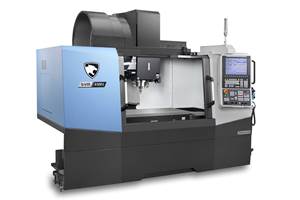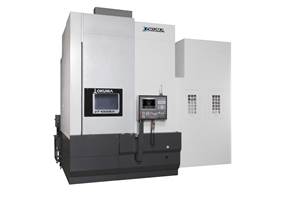A Compact but Rigid VMC for Machining Titanium Blades
In recent years, machine tool builders have developed models specifically designed for the efficient machining of titanium and other hard metals.
In recent years, machine tool builders have developed models specifically designed for the efficient machining of titanium and other hard metals. Machines for very large aerospace parts have been especially notable. However, builders such as Mitsui Seiki (Franklin Lakes, New Jersey) have not overlooked the need for more compact machines that handle smaller titanium parts such as turbine blades for aerospace and power generation. The company’s Vertex 550-5XB is an example of a machine targeted to this market.
This machine occupies 65 square feet of floor space and has travels of 550, 600 and 500 mm in the X, Y and Z axes, respectively. The five-axis VMC addresses many of the same design considerations that characterize larger machines suitable for titanium, but exhibits some significant exceptions, too. A close look at this class of machine is warranted because the advantages of a smaller, application-specific system may be less apparent than in the case of a larger machine. In other words, prospective users will want to know why they need a special machine for titanium instead of a special-purpose machine.
According to Mitsui Seiki, the design criteria identified for this class of machine include a small footprint, the ability to rough and finish parts in one setup, and the capability to achieve high accuracy and improved surface finish. Also required are competitive cycle times and attractive capital cost per part.
Regardless of size, all machines for titanium work must be designed for high rigidity. A rigid machine structure is the foundation for minimizing vibration, which is especially problematic when machining titanium, because spindle speeds tend to be lower and feed rates higher than when machining in aluminum and mild steel. This creates the potential for low-frequency harmonics that produce chatter, and chatter quickly wears the sharp edges on cutter flutes that titanium requires, leading to poor tool life. Designers of large machines generally opt for weight and mass in machine structures to counter this tendency. The same strategy is also effective for a small machine. For example, the Vertex 550-5XB features a single-piece cast bed and a box-in-box design engineered for stiffness while retaining its small footprint.
Likewise, guideway mounting surfaces are hand-scraped because this technique, although more costly, enhances volumetric accuracy and improves vibration damping. The rotary axes are also engineered for accuracy and stiffness. This machine features an unusual rotating/tilting table that balances mass for smooth motion in the A and B axes. The A axis tilts from 0- to 90-degree angles, and the B axis offers 360-degree rotation in 0.001-degree increments. The configuration of the rotary axes is ideal for producing turbine blades from forgings, castings, barstock or solid billets. The design of these rotary axes enables automatic load/unload options such as an articulated arm robot or overhead gantry-style robot. These options make it suitable for placement in a cell or flexible machining system.
Finally, the spindle is designed to maximize bearing support nearest the spindle face and thus minimize this source of vibration. Because the spindle head does not provide a rotary axis for positioning, it can be built more robustly for high thrust forces and high rigidity. Several toolholder interfaces are offered, although HSK is recommended.
For turbine blade production, many manufacturers will find the investment in a VMC designed for this application to be easily justified, especially considering the volume of blades expected to be consumed by aerospace and power generation into the foreseeable future.
Related Content
DN Solutions Introduces High-Productivity Vertical Machining Center
The SVM 5100L’s performance has been optimized to reduce the acceleration/deceleration times of the XYZ axes and spindle, reducing non-cutting time.
Read MoreIn Moldmaking, Mantle Process Addresses Lead Time and Talent Pool
A new process delivered through what looks like a standard machining center promises to streamline machining of injection mold cores and cavities and even answer the declining availability of toolmakers.
Read MoreVertical Lathe Executes Heavy-Duty, Long and Continuous Cutting
New VT1000EX Vertical Lathe from Okuma America Corp. possesses the capability to cut and machine difficult materials through, according to Okuma, its highly rigid, mechanical configuration, extreme thrust and torque.
Read MoreAdditive/Subtractive Hybrid CNC Machine Tools Continue to Make Gains (Includes Video)
The hybrid machine tool is an idea that continues to advance. Two important developments of recent years expand the possibilities for this platform.
Read MoreRead Next
3 Mistakes That Cause CNC Programs to Fail
Despite enhancements to manufacturing technology, there are still issues today that can cause programs to fail. These failures can cause lost time, scrapped parts, damaged machines and even injured operators.
Read MoreThe Cut Scene: The Finer Details of Large-Format Machining
Small details and features can have an outsized impact on large parts, such as Barbco’s collapsible utility drill head.
Read MoreObscure CNC Features That Can Help (or Hurt) You
You cannot begin to take advantage of an available feature if you do not know it exists. Conversely, you will not know how to avoid CNC features that may be detrimental to your process.
Read More


-(1).jpg;width=860)

























